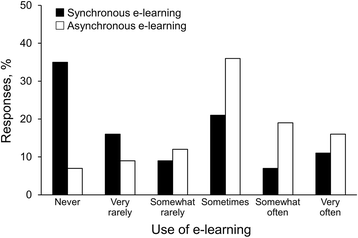E-learning in graduate medical education: survey of residency program directors
- PMID: 28697744
- PMCID: PMC5504987
- DOI: 10.1186/s12909-017-0953-9
E-learning in graduate medical education: survey of residency program directors
Abstract
Background: E-learning-the use of Internet technologies to enhance knowledge and performance-has become a widely accepted instructional approach. Little is known about the current use of e-learning in postgraduate medical education. To determine utilization of e-learning by United States internal medicine residency programs, program director (PD) perceptions of e-learning, and associations between e-learning use and residency program characteristics.
Methods: We conducted a national survey in collaboration with the Association of Program Directors in Internal Medicine of all United States internal medicine residency programs.
Results: Of the 368 PDs, 214 (58.2%) completed the e-learning survey. Use of synchronous e-learning at least sometimes, somewhat often, or very often was reported by 85 (39.7%); 153 programs (71.5%) use asynchronous e-learning at least sometimes, somewhat often, or very often. Most programs (168; 79%) do not have a budget to integrate e-learning. Mean (SD) scores for the PD perceptions of e-learning ranged from 3.01 (0.94) to 3.86 (0.72) on a 5-point scale. The odds of synchronous e-learning use were higher in programs with a budget for its implementation (odds ratio, 3.0 [95% CI, 1.04-8.7]; P = .04).
Conclusions: Residency programs could be better resourced to integrate e-learning technologies. Asynchronous e-learning was used more than synchronous, which may be to accommodate busy resident schedules and duty-hour restrictions. PD perceptions of e-learning are relatively moderate and future research should determine whether PD reluctance to adopt e-learning is based on unawareness of the evidence, perceptions that e-learning is expensive, or judgments about value versus effectiveness.
Keywords: Electronic learning; Graduate medical education; Medical education; Program directors; Residency training.
Conflict of interest statement
Ethics approval and consent to participate
This study was reviewed by the Mayo Clinic Institutional Review Board (Identification number: 08–007125).
Consent for publication
Participation in the APDIM survey includes a statement of intent to publish.
Competing interests
The authors declare that they have no competing interests.
Publisher’s Note
Springer Nature remains neutral with regard to jurisdictional claims in published maps and institutional affiliations.
Figures
References
-
- Means B, Toyama Y, Murphy R, Bakia M, Jones K. Evaluation of evidence-based practices in online learning: a meta-analysis and review of online learning studies. Washington, DC: US Department of Education; 2009.
-
- Pappano L. The year of the MOOC. New York: New York Times; 2012 p. ED26.
-
- Instructional Technology Council. [Internet] 2015 distance learning survey results. Available from: http://www.itcnetwork.org. Cited 16 Sep 2016.
MeSH terms
LinkOut - more resources
Full Text Sources
Other Literature Sources
Miscellaneous


